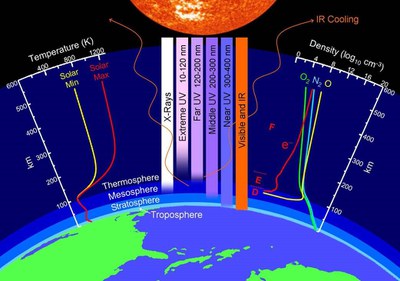Atmospheric layers
Earth's atmosphere has a series of layers, each with its own specific traits. Moving upward from ground level, these layers are called the troposphere, stratosphere, mesosphere, thermosphere, and exosphere. The exosphere gradually fades away into the realm of interplanetary space.
The upper atmosphere begins around 70 km above sea level. At lower altitudes, in the troposphere for example, if a phenomenon such as a thunderstorm flashes creates ions and electrons, they are immediately recombined to give back atoms or molecules, because the atmosphere is dense and they cannot go very far, at most a few millimeters, without hitting a new particle.
Above about 80 km, it is different: the atmosphere is so tenuous that ions and electrons can travel enormous distances, in the order of 10 km to 200 km, before meeting an atom, molecule or other ion. So here we are in a very different environment from all familiar matter, a mixture of neutral gas, more or less excited, ions and electrons. Such a mixture is called a plasma and, in our case, the atmospheric plasma. Neutral gas has been given the name thermosphere. The ionized gas, ions and electrons combined, is the ionosphere. In the ionosphere, we distinguish the D, E and F regions, with approximate heights as indicated below.

The Earth's atmosphere from the bottom upwards: the troposphere, stratosphere, mesosphere, thermosphere. The temperature is shown on the left, both during a solar maximum and a solar minimum. The atmospheric penetration of the various spectral wavelengths of solar radiation is shown in the center. The density of oxygen, nitrogen and carbon dioxide are shown on the right. The letters D, E and F refer to the ionospheric layers. (Credit: John Emmert/Naval Research Lab).
For questions, please contact outreach@pithia-nrf.eu
